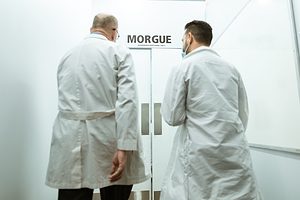If you’ve checked out our resources section, you may have seen information about embalming. As an eco-friendly funeral home, Cremation.Green doesn’t offer traditional embalming services. Why? Because most embalming fluids are extremely toxic and even carcinogenic.
Beyond safety and environmental concerns, some people worry about what happens to cremated remains if someone is embalmed. After all, the cremains are what remains after all the funeral services are complete. And some people choose to keep cremains in their home or use them to make personal items like pieces of jewelry. It’s understandable for families to be concerned about how embalming will affect the cremains.
As a dual licensed funeral director and embalmer I have experience performing services with and without embalming. Here’s what I would discuss with a family that wants to embalm before cremation and is concerned about how it may alter the cremated remains.
Embalming and the Bones
There’s good reason to question what embalming might do to cremated remains. Conventional embalming fluid is made with harsh ingredients that can be harmful to the living. When embalming fluid is used, it mixes with bodily fluids and blood, replacing much of it so that the body is preserved. If the person is buried the embalming fluid can leach into the soil as the body decomposes. If a person is cremated there’s concern over incineration and the air pollution that results from it, which could be more toxic due to the embalming fluid.
The real question for the family is whether embalming affects the bones because that’s what the cremated remains consist of. After cremation all that remains is the bones whether you choose flame cremation or water cremation. The bones are pulverized by a special machine to create the cremated remains.
Because of the way embalming fluids are used and what happens during cremation, it shouldn’t affect the bones that are used for the cremated remains. Embalming fluid evaporates along with other fluids during cremation and is exhausted out of the retort.
Burying Cremated Remains After Embalming
There are many things the family can choose to do with the cremated remains of a loved one. A fair number of families decide to bury the cremated remains so that there’s a permanent resting place. In most cases, this won’t be a problem if embalming was used. However, there is an exception to this rule.
If you plan to bury the cremains in a green cemetery it’s best to not embalm or burial may not be allowed. Green cemeteries have to adhere to very strict guidelines that protect the environment and some green cemeteries go above and beyond the minimum requirements. Even though there are no traces of embalming fluid in cremated remains, a green cemetery may still choose to deny burial to eliminate any potential environmental risk.
In fact, cremated remains can be harmful to the soil regardless of whether or not embalming was used. Many people mistakenly believe you can put cremated remains in soil prior to planting a tree, but that would actually decrease the tree’s chance of survival. Cremated remains aren’t good for soil because it:
- Has a high level of sodium
- Lacks essential micronutrients
- Is high in calcium leading to a loss in nitrogen
- Has a high pH level
For these reasons, you have to be careful when you are burying cremains, especially in a green cemetery. If you want to bury cremated remains where plants are intended to grow, the cremains should be treated first to avoid the issues outlined above. In particular, the pH level needs to be addressed so that the soil can sustain plant life.
Why You Still May Want to Avoid Traditional Embalming
At the end of the day, embalming is an option not a necessity. Although embalming won’t necessarily make burial impossible, you may still want to avoid traditional embalming methods for the reasons mentioned below.
It’s Potentially Harmful to People and the Environment
As already mentioned, traditional embalming fluids simply aren’t safe. The worst ingredient is formaldehyde, which is now known to be carcinogenic. We embalmers have to be very careful when using traditional embalming fluids because of the risk to our own health. At a minimum exposure can cause eye and throat irritation. At worst, exposure to the formaldehyde in embalming fluids can cause cancer. Research has shown that embalmers have a higher chance of getting leukemia than the general public.
There Are Healthier Embalming Alternatives
As an embalmer, I understand there are options beyond traditional embalming fluids. Unfortunately, many people don’t realize there’s more than one way to embalm, and some funeral directors only use conventional methods. They simply don’t know that eco-friendly alternatives to embalming fluid exist to even recommend them.
And there’s no need for embalming at all if you opt for direct burial or direct cremation. If you do want to have funeral services prior to cremation, there are healthier options like dry ice or the Enigma line of embalming fluids from Champion that don’t contain formaldehyde.
For these reasons, I always suggest that families seriously consider the use of conventional embalming fluids and carefully weigh all of their options. Not only is it safer to skip the embalming, it’s also less expensive. The National Funeral Directors Association (NFDA) estimates that the cost of embalming is $845 on average.
Want to know more about healthier, eco-friendly funeral services? I’m happy to share information about the latest in green death care options and how we can help minimize the impact of the funeral services you select.
I’m available by phone, text or email any day of the week.






